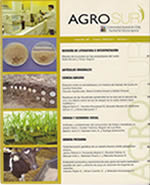Frequency and intensity of grazing in winter: their effects on herbage accumulation and nutritive value of Lolium perenne L. dominant swards
Main Article Content
Abstract
A study was conducted in southern Chile with the objective of determining the effect of two frequencies and two intensities of grazing, measured as herbage mass, on production and nutritive value of a permanent sward dominated by Lolium perenne L. during winter season. Additionally the residual effect of the treatments applied in winter was evaluated on the same variables in the following spring. Two pre-grazing herbage mass (kg DM ha-1): low frequency (1,800), high frequency (1,500) and two post-grazing herbage mass: low intensity (1,300), high intensity (1,000), were evaluated. Plots of 145.7 m2 were grazed by dairy cows. The same plots were grazed in the subsequent spring to a frequency of 2,400 kg DM ha-1 and intensity of 1,400 kg DM ha-1. There was no significant effect of the frequency of grazing on herbage mass and growth rate during the first winter. However, in the second winter a greater production with low frequency was obtained. In the two winter seasons, a significant effect of the intensity was obtained, with greater production in high intensity. The most frequently grazed treatments showed higher crude protein and lower soluble carbohydrates. Also, there was a residual effect in the spring generated by frequency and intensity of grazing in the first year, and only for the intensity the second year. It can be concluded that frequency and intensity of grazing applied in winter generate changes in herbage mass production and nutritive value of the sward and also a residual effect in the following spring.

